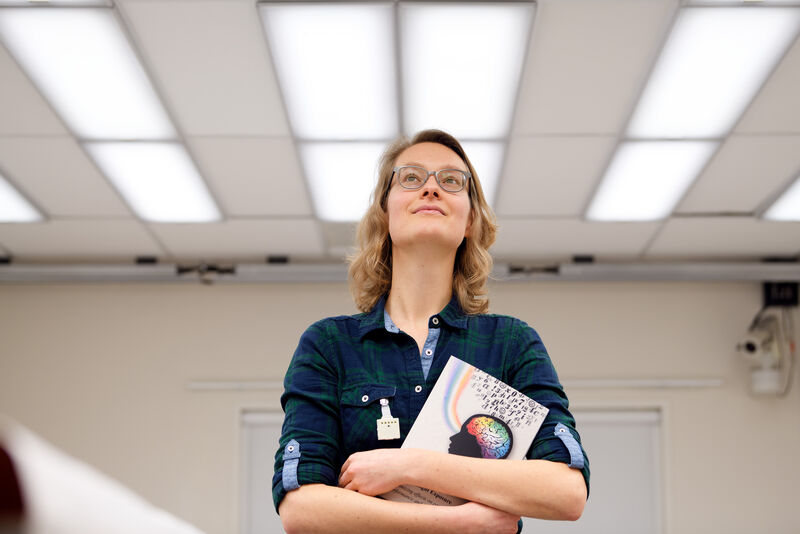
- Research , Home Stretch
- 31/01/2018
Home Stretch | Does more light raise performance?
The amount – and the color – of the light to which you are exposed influences your mood, alertness, and ability to carry out complex tasks. If we had a better understanding of how this works, we could adapt the lighting in offices and lecture theaters accordingly. In view of this, PhD candidate Laura Huiberts of Human-Technology Interaction put dozens of test subjects through a range of tests.
Our retina, at the back of the eyeball, is full of light-sensitive cells. The most well-known are the rods – very light-sensitive, but unable to distinguish colors – and three types of cone, which you use to see colors. Only since the beginning of this century have we known that our eyes possess a third type of cell; these cells send information about the incoming light to the brain. They are the light-sensitive ganglion cells.
In contrast to the cones and rods, these ganglion cells do not help us form an image of our surroundings. But that does not mean they aren't important: these cells can have a considerable influence on your mood and sleep pattern, for example. They ensure that our biological clock is reset every day: people who live in darkness for a prolonged period soon experience a sleep-wake rhythm that is out of step with a regular pattern.
Moreover, it has lately become clear that the amount– and the color– of light to which you are exposed has immediate consequences for how fit you feel, how alert you are, and how well you can perform diverse tasks. A subtle adjustment to (office) lighting, could potentially have a significant influence on the performance of employees or, say, students.
Inconsistent
All this was reason enough to spur PhD candidate Laura Huiberts to find out exactly what effects can be achieved with various levels of light– after all, the mountain of scientific literature contains a fair number of apparently inconsistent results. “This may well be because the effect of lighting is determined by other variables, such as the complexity of the task or the time of day and the season,” she explains.
To gain an insight into the influence of such additional circumstances, Huiberts put groups of test subjects – mainly students – through their paces doing tasks that required them to use their working memories to varying degrees. “We put them to work in an office room with ordinary light conditions, as well as in a much brighter environment with up to 1700 lux on the eye”, she explains.
Spring and fall
These experiments were conducted in the morning and afternoon and in both the spring and fall. Huiberts compared not only the objective findings, but also asked the participants about their own experience: how did they feel?
In addition, Huiberts looked at whether her subjects' performance depended on the extent to which they were physically energized by the light. “To do that, we measured heart rate, blood pressure and the conductivity of the skin.” That result of that was immediately striking, she says. “In contrast to what is claimed in the literature, we saw no link between so-called physiological ‘arousal’ and performance.”
No logic
Despite the considerable number of test subjects – more than sixty; according to the PhD candidate, an extremely high number for studies of this kind – in Huiberts’ results there appeared to be no logic in the link between bright light and better performance at memory tasks. What was evident, however, was that exposure to a great deal of light has a positive effect on feelings of alertness and fitness in the winter, but nog in the spring, and this was reflected in how well the test subjects performed at a task requiring alertness.
In addition, she saw that test subjects who had spent the hour preceding the test in light surroundings started to feel sleepy under normal office lighting. “Thanks to an exposure to a high level of light, they seemed to have become more sensitive, as it were, to a light deficit.”
Sleep-wake rhythm
One last notable finding was that the test subjects who had participated in the tests in the morning under bright light reported that they felt less well later in the day and that they slept less well the following night. “That was exactly the opposite of what you would expect,” says Huiberts.
It may well be the price to be paid for testing mainly students. “Most students aren't yet fully awake at 9 o'clock in the morning; by exposing them to bright light at that moment of the day you are disturbing their sleep-wake rhythm,” she says by way of explanation. “This isn't a problem in itself, but they should have gone to bed earlier the night before the tests. In many cases, no doubt, their social obligations meant their good intentions went out the window.”
Photo | Bart van Overbeeke
Discussion